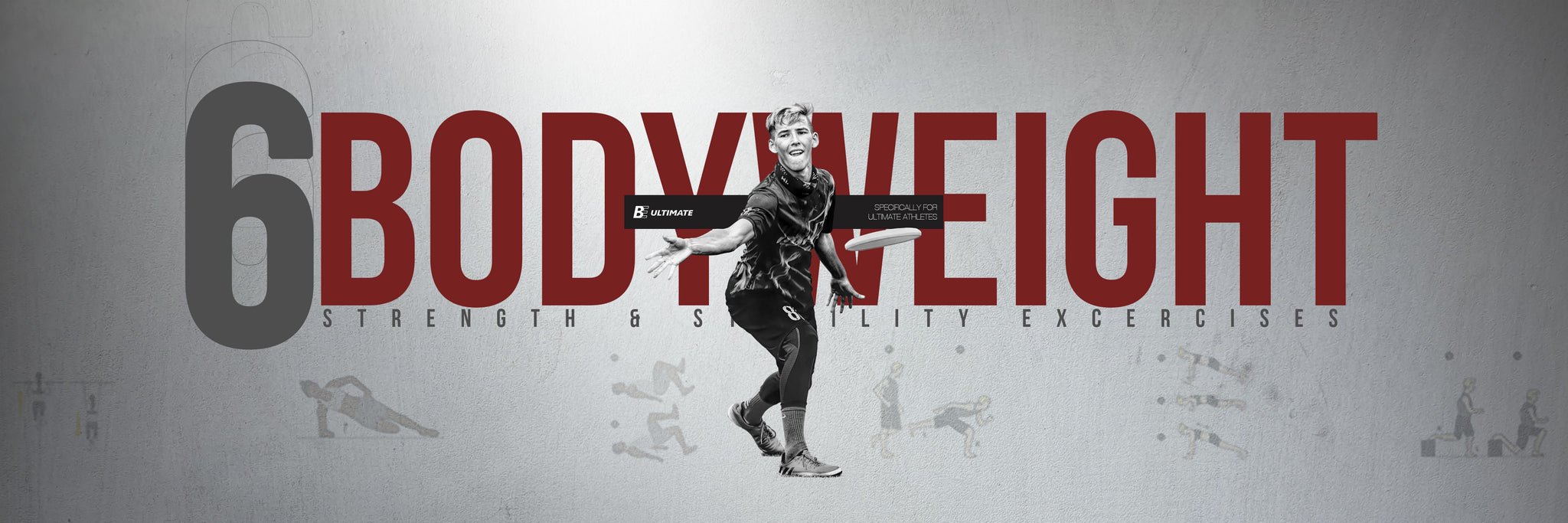6 Great Bodyweight Exercises for Strength and Stability specifically for Ultimate athletes

Strength training presents a distinct challenge, since it typically requires the use of weights or machines to reach maximum potential. But even without equipment, it’s possible to build muscle and keep fitness levels high. We sat down with JP Riopel from Specifik Ultimate to get some tips on how to train using only bodyweight, as well as some exercises you can try yourself. Most of these exercises can be found in our IGNITE Program for further at-home training.
The key to bodyweight exercises is finding a way to make the load, or weight, high enough to make the movement challenging. They’re a great way to learn a movement which you can build on later. Many conventional movements in the gym can be performed as bodyweight exercises, the difference being the way in which you find that extra load. We’ll go over those ways to find some extra resistance using only your body.

Single Leg (Pistol) or Raised Leg (Bulgarian) Squats:
*Graphic shows a Bulgarian Squat*
A classic movement - the squat - works a huge portion of your lower body. Regular squats on their own can be a great bodyweight exercise, but if they’re not challenging enough try these variations. The Bulgarian Squat raises one leg on a higher surface so that the leg still on the ground lifts more of your weight, increasing the load. The Pistol Squat is the same concept to a greater extent, requiring balance to use only a single leg to complete the whole squat movement.

Pushups (with variations):
A common exercise, the pushup large parts of the upper body. It mirrors a chest press, except with your own weight rather than a barbell or dumbbells. You can focus on different muscle groups by adjusting your grip (i.e. wide, narrow, offset), adjusting your leg positioning (i.e. raised, wide, narrow), and increase weight by using one hand instead of two. .

BE Ultimate IGNITE Program
Complete at-home workout built for ultimate athletes

Single Leg Deadlift:
The single leg deadlift works your hamstrings (a muscle which squats don’t target) - an absolute necessity to train for an ultimate player. This movement is done by standing tall, then bending at the waist keeping one leg on the ground and the other straight in line with your upper body. Bend until your body forms a rough T shape and then tilt back up until straight. This works the hamstring in the same way as a weighted deadlift, by using one leg instead of two.

Hip Bridges:
Lie on the floor with your heels near your glutes, and push through them using your upper back to brace against the ground. This movement works your glutes and is excellent for stabilizing your hips. If the exercise is too easy with both legs, use one instead, essentially doubling the weight.

Plank (with variations):
This is a great isometric exercise for working your core, upper shoulders and stability. You can do it by simply holding a pushup position with arms extended or holding the position with forearms on the ground. Variations include raising your feet, using one arm, or doing a side plank, where your side is parallel to the ground instead of your front. If you want some movement with your plank, try doing pushups into plank, rotating between right and left side planks, or adding leg movements while in plank. Each of these will create more difficulty and work a wider variety of muscles.

Chin-ups/Pull-ups (only possible with a bar):
Movement types that are harder to achieve without equipment are pulling motions. If you have access to a pull-up bar you can solve this to a certain extent, using the bar for chin-ups and pull-ups works out your upper back and arm muscles that are more difficult to reach without equipment.
Before getting started, if you’re new to training or looking to get more serious about it, we highly recommend getting advice from a professional. A physiotherapist, strength coach or athletic trainer specialized in ultimate like JP Riopel is going to be able to make sure safety comes first and that you make the most of training time.
You can also add additional variation to each of these exercises by adjusting the number of reps, sets, and tempo. Doing one long, slow rep is harder than doing one fast one, so if your routine begins to feel easy, try slowing it down. You can also continue adding to the number of reps in a row, or number of sets. It’s important to note, however, at a certain point you may no longer be challenged by bodyweight movements. If you find you can do a huge number of reps without feeling strained or tired, it’s probably time to find a way to add a challenge. If you’re looking for a multipurpose piece of equipment that can be used in a wide variety of ways, try resistance bands. They can be used in many exercises and create a greater challenge when performing them. If you have a great bodyweight circuit, another way you can increase challenge is by wearing a weighted vest, a single piece of equipment that can make each of these exercises more difficult. *You can make your own weighted vest by adding heavy objects to a backpack* Always remember to stay safe, and focus on performing a movement correctly. By building a solid foundation, you can ensure your training will progress well in the future.
IGNITE TRAINING PROGRAM
We have brought together some of the best minds in ultimate-specific training to give you an introductory guide to working out.


